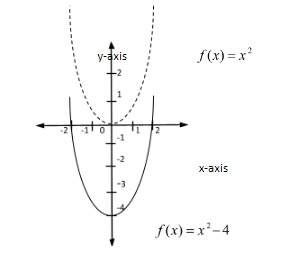
How is the graph of \[f(x) = x{}^2 - \,4\] related to that of \[f(x) = x{}^2\] ?
Answer
547.5k+ views
Hint: The above question is related to the transformation of graphs. The original graph of the equation \[f(x) = x{}^2\] is an upward opening parabola with vertex at origin. In the new equation \[f(x) = x{}^2 - \,4\] ,the function change is along the y-axis. The remaining nature of the parabola remains the same. Thus it is only required to shift the vertex of the original equation to obtain the new one.
Complete step-by-step answer:
The function \[f(x) = x{}^2 - \,4\] can be written as \[{x^2} = f(x) + 4\] and the function \[f(x) = x{}^2\] can be written as \[{x^2} = f(x)\] . Now the function \[{x^2} = f(x)\] represents an upward opening parabola with its vertex at origin. Now, if we compare the second equation \[{x^2} = f(x) + 4\] with the first one, we can see that that the left hand side of both the equations are same but the right hand side of second equation is 4 units less than the previous one.
Therefore, the equation \[f(x) = x{}^2 - \,4\] can be obtained by shifting the equation \[f(x) = x{}^2\] four units in the downward direction. Hence the graph is transformed as below.

Hence we can observe that the graph of the equation \[f(x) = x{}^2 - \,4\] can be obtained by shifting the graph of the equation \[f(x) = x{}^2\] along the y-axis in the negative direction.
Note: There are some basic graphical transformations of parabolas which are to be noted. The function \[f(x) = x{}^2 + b\] has a graph which simply looks like the standard parabola \[f(x) = x{}^2\] with its vertex shifted \[b\,\,units\] along the y-axis. Thus the vertex will be located at \[(0,b)\] . if \[b\] is a positive value then the parabola moves \[b\,units\] upwards and if the value of \[b\] is negative then the parabola moves \[b\,\,units\] downward. Another form of parabola has the equation \[f(x) = {(x - a)^2}\] which has the graph same of that of \[f(x) = x{}^2\] with its vertex shifted \[a\,\,units\] along x-axis. If \[a\] is positive it shifts \[a\,\,units\] to the right and if the value of \[a\] is negative it shifts \[a\,\,units\] to the left .The the vertex of the parabola changes to \[(a,0)\] .
These two types of transformation can be combined to produce a parabola which is congruent to the basic parabola but with vertex at \[(a,b)\] .
Complete step-by-step answer:
The function \[f(x) = x{}^2 - \,4\] can be written as \[{x^2} = f(x) + 4\] and the function \[f(x) = x{}^2\] can be written as \[{x^2} = f(x)\] . Now the function \[{x^2} = f(x)\] represents an upward opening parabola with its vertex at origin. Now, if we compare the second equation \[{x^2} = f(x) + 4\] with the first one, we can see that that the left hand side of both the equations are same but the right hand side of second equation is 4 units less than the previous one.
Therefore, the equation \[f(x) = x{}^2 - \,4\] can be obtained by shifting the equation \[f(x) = x{}^2\] four units in the downward direction. Hence the graph is transformed as below.

Hence we can observe that the graph of the equation \[f(x) = x{}^2 - \,4\] can be obtained by shifting the graph of the equation \[f(x) = x{}^2\] along the y-axis in the negative direction.
Note: There are some basic graphical transformations of parabolas which are to be noted. The function \[f(x) = x{}^2 + b\] has a graph which simply looks like the standard parabola \[f(x) = x{}^2\] with its vertex shifted \[b\,\,units\] along the y-axis. Thus the vertex will be located at \[(0,b)\] . if \[b\] is a positive value then the parabola moves \[b\,units\] upwards and if the value of \[b\] is negative then the parabola moves \[b\,\,units\] downward. Another form of parabola has the equation \[f(x) = {(x - a)^2}\] which has the graph same of that of \[f(x) = x{}^2\] with its vertex shifted \[a\,\,units\] along x-axis. If \[a\] is positive it shifts \[a\,\,units\] to the right and if the value of \[a\] is negative it shifts \[a\,\,units\] to the left .The the vertex of the parabola changes to \[(a,0)\] .
These two types of transformation can be combined to produce a parabola which is congruent to the basic parabola but with vertex at \[(a,b)\] .
Recently Updated Pages
Master Class 8 Maths: Engaging Questions & Answers for Success

Class 8 Question and Answer - Your Ultimate Solutions Guide

Master Class 7 Maths: Engaging Questions & Answers for Success

Class 7 Question and Answer - Your Ultimate Solutions Guide

Master Class 6 Maths: Engaging Questions & Answers for Success

Class 6 Question and Answer - Your Ultimate Solutions Guide

Trending doubts
What is meant by exothermic and endothermic reactions class 11 chemistry CBSE

Which animal has three hearts class 11 biology CBSE

10 examples of friction in our daily life

One Metric ton is equal to kg A 10000 B 1000 C 100 class 11 physics CBSE

1 Quintal is equal to a 110 kg b 10 kg c 100kg d 1000 class 11 physics CBSE

Difference Between Prokaryotic Cells and Eukaryotic Cells




